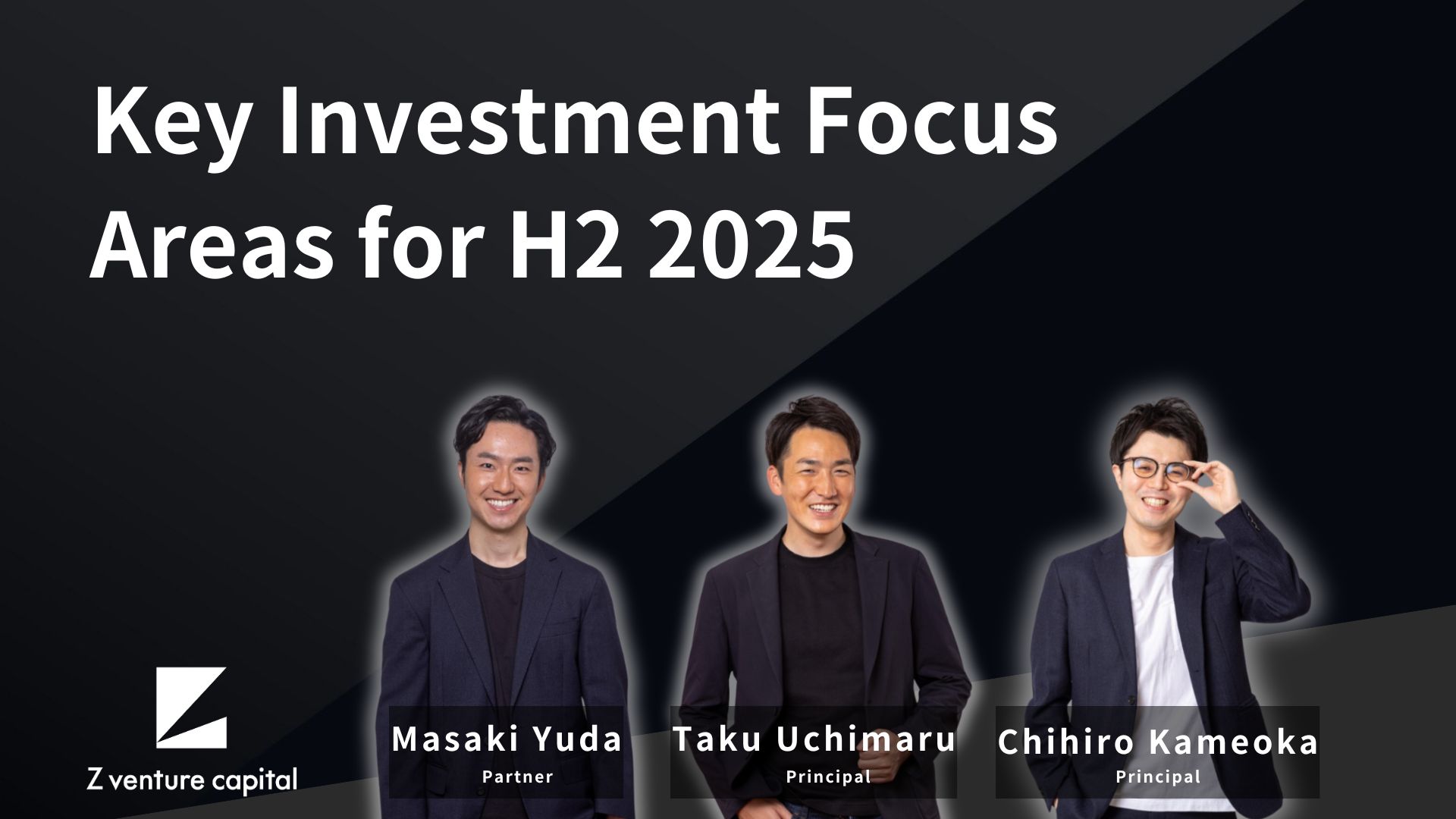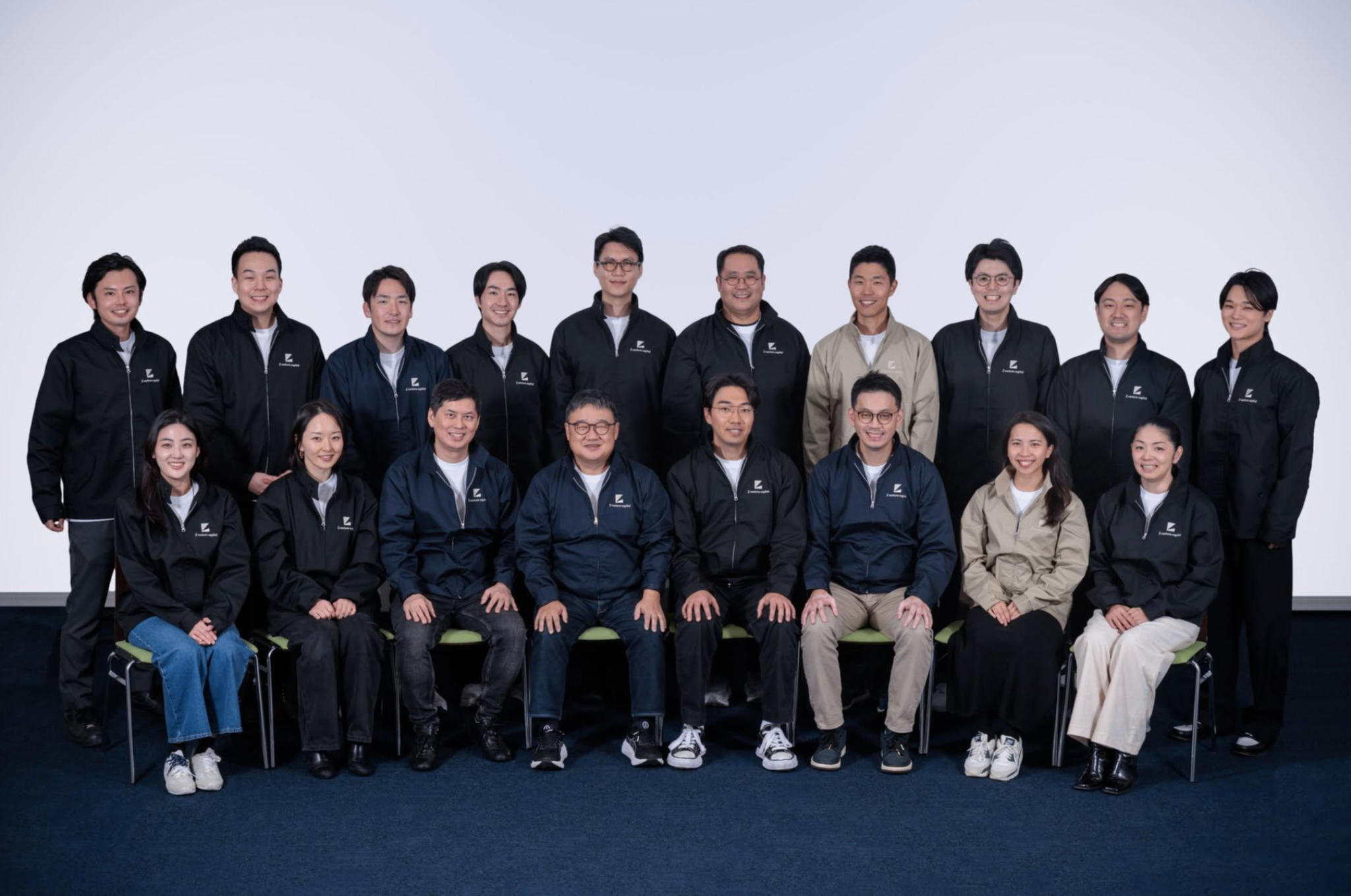
Key Investment Focus Areas for H2 2025 / Japan
In January 2025, Z Venture Capital (ZVC) launched its second fund—ZVC Fund II—with a total size of approximately 30 billion yen. Within just six months, we’ve made around 20 new investments through the fund, spanning our key focus areas such as AI, media, commerce, and fintech. We’ve also begun actively investing in deep tech, including startups in the space sector.
So, where are ZVC's investment members seeing the most potential right now? What themes are we doubling down on? In this new column series, “Key Investment Focus Areas for H2 2025,” our team members from Japan, Korea, and the U.S.—ZVC’s core hubs—will share the trends and sectors we’re most excited about heading into the second half of the year.
We hope this series leads to new conversations and connections with startups around the world. First up: insights from our team in Japan.

Physical AI — Augmenting the Human Body to Address Labor Shortages
AI adoption is quickly moving beyond the office and into the physical world. One area I’m especially excited about is what we call “Physical AI.”
During a recent visit to a rural convenience store, I was surprised to find that it wasn’t open 24 hours—a reminder of the growing challenges around labor shortages and depopulation in regional areas. In response to this, new technologies that extend human physical capabilities, perception, and decision-making are starting to gain real traction across industries like construction, manufacturing, caregiving, and logistics. We’re now seeing robots that can learn and replicate the skills of experienced workers, hands-free user interfaces powered by voice commands and eye-tracking, and other breakthroughs driven by the evolution of multimodal AI. These innovations are giving rise to a new kind of workforce—one where humans and AI work side by side in physical environments.
Japan has long been a leader in robotics, with globally recognized research in areas like tactile and manipulative technologies. I believe there’s a real opportunity here for world-class startups to emerge and lead this next wave of innovation.
Data × AI Infrastructure — The Rise of “Data Enablers” Driving Real-World AI
As AI becomes more widely adopted, we’re seeing a clear shift in where value lies—from algorithms to data. What’s becoming increasingly important is the infrastructure that supports AI at scale: collecting and storing raw data, building real-time feedback loops, and organizing unstructured data into usable formats.
This is the foundation that makes real-world AI possible.
We’ve been paying close attention to this space for a while, but with the pace of AI adoption accelerating, we believe the data infrastructure market is entering a new phase of growth. In particular, we see growing importance in the role of “Data Enablers”—startups that specialize in building quality datasets and structuring data to support AI implementation.
This is an area we’re actively tracking again, and we believe these enablers will play a central role in shaping the next stage of AI's evolution.

Agentic Commerce & AI for Essential Workers — AI Is Eating the World
“AI is eating the world.” It’s a phrase that feels more real every day as we watch how fast the technology is evolving. At ZVC, we’re seeing more and more of our portfolio companies go beyond using AI just for software development or customer support—they’re starting to redesign entire workflows with AI at the center. And this shift is only accelerating. AI is becoming a core part of how businesses operate.
Looking ahead, we’re excited about the rise of Agentic Commerce—a future where AI agents actively participate in economic activity. We expect to see startups that bridge fragmented business tools like SaaS with B2B transactions, unlocking seamless, automated workflows and driving the next wave of B2B e-commerce.
At the same time, while AI adoption is growing rapidly across desk-based tasks, we believe some of the biggest opportunities lie in industries where labor shortages are most severe—caregiving, logistics, construction. These are essential jobs, and they’re exactly where AI can make the biggest difference. This is a rare case where social impact and financial returns are deeply aligned, and it’s why we’re actively exploring startups building AI solutions for essential workers. We believe this will become one of the defining investment themes in the years ahead.
Space & Deep Tech — A Rare Opportunity to Catch an Industry at Lift-Off
With the launch of our second fund earlier this year, we’ve begun making investments in the deep tech space—and one area we’re especially excited about is space.
Just like the internet in its early days, the space industry is now entering a breakout phase. In Japan, the government has started backing the sector through initiatives like the Space Strategy Fund and SBIR, signaling the start of something big.
We’re particularly interested in businesses related to satellites—whether it’s hardware, software, or applications of satellite data—as well as new services that will be created in orbit. With the number of satellites expected to grow exponentially, this is a once-in-a-generation opportunity to help shape a massive new industry from the ground up. If you're building in space—or thinking about it—we’d love to hear from you.

Content × AI — Reinventing How the Next Generation of Content Gets Made
Content is one of the few categories where Japanese startups have the potential to make a global impact. At the same time, even in areas where Japan has long held an edge—like anime and gaming—rising costs and talent shortages are starting to take a serious toll.
In anime, for example, there’s a growing shortage of animators, and it’s not unusual for a project to take two to three years from start to finish. In gaming, skyrocketing labor costs and higher expectations for quality are making it harder to complete titles—leading to more projects getting canceled mid-way.
That’s why I’m paying close attention to startups using AI to fundamentally change how content is created. If we can streamline and modernize production processes, it gives creators more chances to “step up to the plate”—to experiment, take risks, and produce more ambitious content without being held back by time or cost.
Traditionally, producing high-quality anime or games required deep technical expertise, which made it difficult to scale user-generated content (UGC) in these fields. But with the evolution of AI tools, we’re starting to see new ways for users to create and publish content themselves—opening the door to a new wave of UGC-driven innovation.
I’m especially eager to connect with founders working at the intersection of AI and content creation—this is a space full of potential.
Real-World Business × AI / Robotics / Roll-Ups — Winning Through Operational Efficiency
It’s been nearly two decades since “DX” (digital transformation) became a buzzword. In that time, major players have already carved out strong positions in large horizontal and vertical markets. As a result, the opportunity to build a pure software play is shrinking, and we believe the next wave of startups will need a different approach.
One compelling path forward is to combine software with real-world operations. Startups that don’t just offer IT solutions, but also operate and optimize physical businesses using those tools, have a distinct advantage.
In these cases, AI and robotics can be powerful levers for driving efficiency. And to accelerate growth further, roll-up strategies—acquiring and integrating multiple offline businesses—can be an effective way to scale.
In fact, in my previous role, I worked on a roll-up deal where we acquired a group of veterinary clinics without successors and streamlined their operations. That experience shaped how I think about this model, and it’s why I’m especially excited to meet founders taking on similar challenges today—combining tech, real-world business, and smart execution to unlock value.
 Share
Share Share
Share Share
Share


